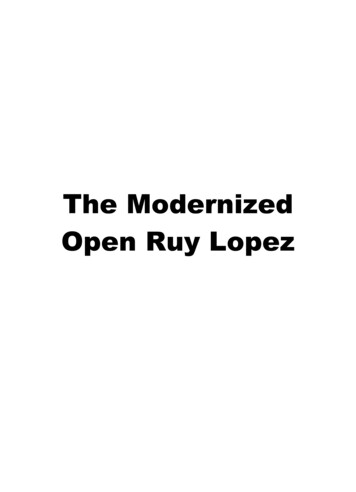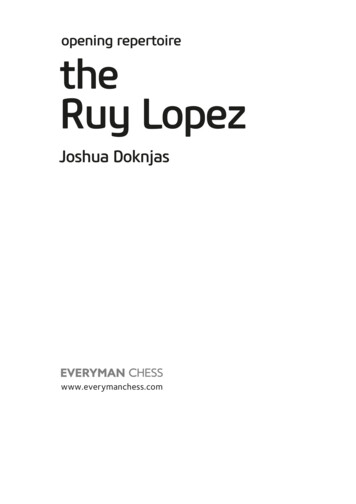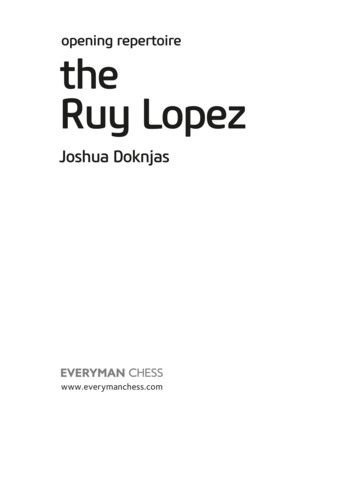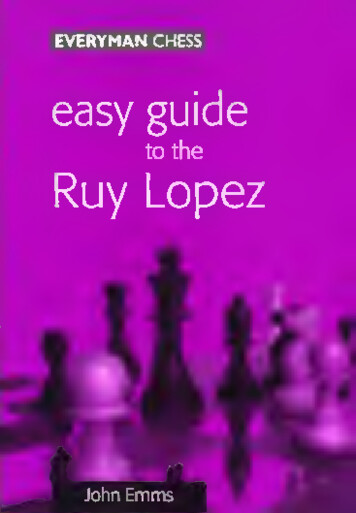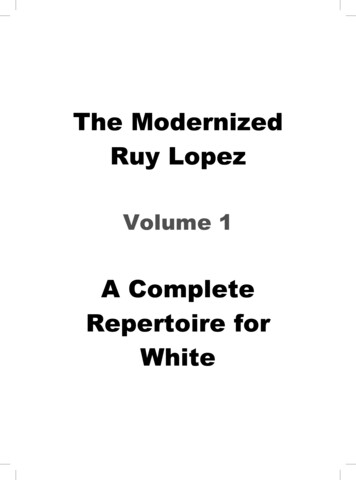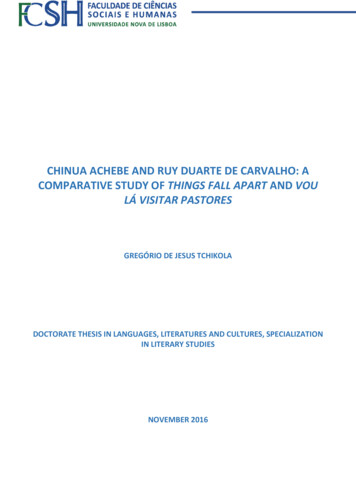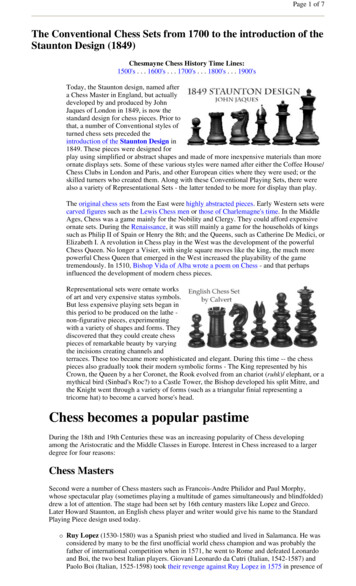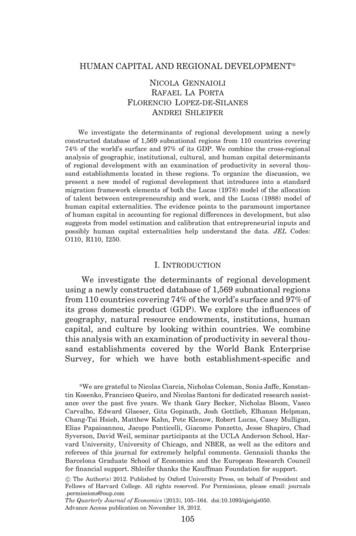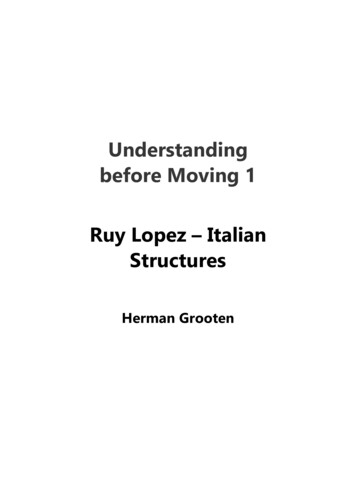
Transcription
Understandingbefore Moving 1Ruy Lopez – ItalianStructuresHerman Grooten
First edition 2018 by Thinkers PublishingCopyright 2018 Herman GrootenAll rights reserved. No part of this publication may be reproduced, stored in a retrieval system or transmitted in any form or by any means, electronic, mechanical,photocopying, recording or otherwise, without the prior written permission fromthe publisher.All sales or enquiries should be directed to Thinkers Publishing, 9850 Landegem,Belgium.Email: info@thinkerspublishing.comWebsite: www.thinkerspublishing.comManaging Editor: Herman GrootenAssistant Editor: David Koetsier, Bernard Carpinter, Zyon KollenSoftware: Hub van de LaarGraphic Artist: Philippe TonnardCover Design: Mieke MertensPhoto Cover: Ab Scheel Production: BESTinGraphicsISBN: ISBN 9789492510372D/2018/13730/19
Understandingbefore Moving 1Ruy Lopez – ItalianStructuresHerman Grooten
Thinkers Publishing 2018www.thinkerspublishing.com
Explanation of symbols:!?!!?!?! good moveweak moveexcellent moveblunderinteresting movedubious moveonly movebalanced positionunclear positionwith compensation for thesacrificed materialWhite is slightly betterBlack is slightly better - N# White has a clear advantageBlack has a clear advantageWhite is winningBlack is winningwith an tattackinitiativelead in developmentcounter-playwith the ideabetter isnoveltycheckmatecheckNext to most diagrams you’ll see a small square on the right. If it’s White, it meansit’s white’s move; if it’s Black, it means it’s black’s move.BibliographyFundamental Chess OpeningsQueen’s Indian Defence – Kasparov SystemHow to Open a Chess GameAusgewählte PartienMy Sixty Memorable Games– Paul van der Sterren– Mikhail Gurevich– Larry Evans– Paul Keres– Robert James FischerMega Database– Chessbase
Visual aidsIn this book we’ll regularly use different kinds of visual aids. As a chess trainer I havenoticed that visualizing specific strategic or tactical ideas can be illuminating.Since I often make use of a projector I canhighlight essential points by marking squaresand indicating with arrows where a piecewants to go.Our software developer Hub van de Laar hasput together many nice arrows and markingsthat enable the reader to focus on the position’s essence at a single glance. In the adjacent diagram we can immediately see whatWhite is threatening and “what other arrowhe possibly has left in his quiver”. This position is taken from the splendid attackinggame Van der Wiel-Ernst, Groningen 2004, in which White sacrifices his queen inexchange for two minor pieces, greater activity and a large number of threats.To indicate moves in this book we won’t use letters to denote the pieces concerned,but the so-called figurines. A small QRBN–FigurineKQRBN-
ContentsExplanation of symbols and ------------ 5Animations and visual aids ------------------ 6Contents ----------------------------------------- 7Preface ------------------------------------------- 7Chapter 1Chapter 2Chapter 3Chapter 4Chapter 5Chapter 6Chapter 7Chapter 8Studying of --------------- 9Behind the Scenes of Openings ------------------------------------------ 17Pawn Structures ----------- 23Overview of the Ruy --- 37Overview of the Italian Game -------------------------------------------- 53Model Games -------------- 79Exercises -135PrefaceA wild and original idea does not often turn out to be a successful concept. This istrue not only for chess itself, but also for a chess writer’s practice. Nevertheless, webelieve that the fundamental concept behind this book is one that will prove veryvaluable to average club player.As a trainer of both youth and adult players I look at many games of my students. Inoticed many of them had enough knowledge of the opening at their disposal. Yetas soon as the opponent deviated from theory, they were groping in the dark. Because how should the game continue?This book series is about that central question: what matters in the opening? Whatplans are on hand? Which (hidden) concepts are concealed in the current positionthat has arisen just after the opening?
In Schaakmagazine, the journal of the Royal Dutch Chess Federation, I started writing a series of articles in which I go into the above-mentioned issues. I tried to clarifyin this series what specific openings are really all about, without falling into complicated side-lines.This line of thought may have begun with my own irritation when I tried learningopenings from a book myself. My dislike of a “variation tree”, in which deviationsare written down like, for example, B1.2a) or C4.3b1), not only made my wirescross, but also took away the pleasure of learning new things about chess. The attentive reader will catch me later using a similar way of enumerating in this book.Yet I hope the explanations accompanying the variations won’t make you quit reading!When I became better and got more understanding of the strategic ideas withincertain openings, I became much more capable of studying an opening. I mainlyowe this understanding to the grandmasters who were willing to write theirthoughts down, of course accompanied by variations.In my view the average club player will be more pleased with an opening book inwhich a profusion of ideas is offered. If this is also structured, you can hope thatthe readers will acquire the necessary understanding of standard positions. On thebasis of this guideline, developing an opening repertoire could easily turn into apleasant pastime. Together with my Belgian chess pal Daniel Vanheirzeele, theowner of Thinkers Publishing, I have been enabled to discuss the backgrounds ofopenings in a much more detailed manner, something I couldn’t do in my articleseries because of the lack of space.We hope to take the reader from the opening into the unfathomable depths ofgrandmaster chess. Here we try in a way of our very own to give a full explanationof the many plans, ideas and concepts that remain often hidden under the surface.In this way we hope to give the club player something to hold on to, as he reallywants the question answered: how to continue if the opponent deviates from theory?We wish you a lot of enjoyment and growth in working through this first book of anew series.IM Herman Grooten, September 2018.
1. Studeren van openingen9Studying of OpeningsIntroductionThe topic of openings interests many chess players. This has always been the case,but the study of openings has significantly increased due to the massive advancement of computers and software. These days almost every self-respectingplayer owns a laptop with a large number of games, a database, and a strong engine.Where does this desire to study openings come from? The answer seems obvious.There is an enormous amount of material available, which allows for very concrete work. One can spend copious amounts of time on it. Many club players loveto have a chessboard and a book on the table to analyze an opening. They tend toassume that putting in hours of study will lead to better results. Especially tournament tigers who believe that enough input will automatically lead to a higherElo rating.In my many years as a chess coach, I have had the opportunity to work with lots oftalented junior players. However, I have also worked with ambitious club playerswho wanted to increase their skill level. By questioning their work ethic in theirhome study, I started to notice that many players spend large amounts of time onopenings, but gain very few benefits. So where is the mismatch?
10Ruy Lopez – Italian StructuresI observed that people mainly attempted to memorize moves. The complexities ofmany openings appeared to be so difficult, that people tried to rely on theirmemory and not on improving their insights. You can’t blame them, the game ofchess is difficult to understand. Nevertheless, I am of the opinion that there areother methods to try to comprehend and study openings in a much more purposeful manner. In this series, I would like to try to answer this question withwhich many players struggle.A crucial part of our answers is based on the creation of a greater understandingof the positions shortly after the crucial opening moves. We will focus on bringingthe reader to understand the pawn structures within the variety of openings, andto the plans and concepts that can be derived from these structures. We will alsoreview characteristic games by grandmasters, preferably top players. Strong chessplayers often know intuitively where the pieces belong. As a result, many questions need to be asked: Which plans belong within the sometimes completely different structures? How does a top player distill from the many features the right plan? Where do the pawns belong? Which pieces need to be traded and which ones do I prefer to keep on theboard? How can I plan an attack? How do I cut through the game of my opponent?We are going to change the study of the openings in such a way that we will improve readers’ strategic vision, which is how this book will help club players.Through conversations I have had with the grandmaster and famous chess coachAdrian Mikhalchishin, formerly Ukrainian and nowadays Slovenian, it becameclear that players can improve their strategic planning through replaying games ofgrandmasters. Essential to these are verbal explanations to these games, supported by the most important variations. As Mikhalchishin said, “Replaying games ofall world champions is compulsory in Eastern Europe.” Would that be the secret towhy busloads of strong players continue to arise out of nowhere?But how can you lift your own level through randomly replaying games? He didelaborate that a good method could be to replay games that fit the variations youplay yourself. That way you kill two birds with one stone. You play a game andthen afterward you search for a game by a strong grandmaster who discusses and
Chapter 1 – Studying of Openings11reviews the position you have just played. There couldn’t be a better motivationto study that game!The Dutch grandmaster Loek van Wely admitted one day he was surprised at theway some players treated the Sveshnikov variation of the Sicilian, which arises after, for example: 1. e4 c5 2. Nf3 Nc6 3. d4 cxd4 4. Nxd4 Nf6 5. Nc3 e5 6.Ndb5 d6 7. Bg5 a6 8. Na3 b5 9. Bxf6 gxf6 10. Nd5.Position after: 10. Nd5Loek van Wely (photo Jos Sutmuller)One of the starting positions of theSveshnikov. Without knowledge ofthe power of the bishop pair, this position becomes unplayable.In this variation, Black straight away abandons the important central square d5,and then voluntarily allows doubled pawns on f7 and f6, and on top of that, hecastles on that side. How can something like that be playable? Everything is aboutactivity. Black compensates for his strategic defects by making his pieces as activeas possible. If you get this kind of position on the board, you need to understandhow to play with the bishop pair. Without any comprehension, this opening becomes unplayable.Van Wely noticed that some players gave up the bishop pair without hesitationand thereby lost a large part of their compensation. What this means is that the
12Ruy Lopez – Italian Structuresguidelines of the middlegame need to be studied, before one can start on theopening variation. And that same idea also applies to the Ruy Lopez.Former world champion Anatoly Karpov once said that if you want to become astronger player, one needs to immerse oneself in the Ruy Lopez with both colors.This difficult opening, in which there are many tensions, requires a deep understanding of the transition into many other different structures. For example, theposition can suddenly be closed and start to show resemblances to the King’s Indian, an opening that of all things starts after 1. d4. To see if something is favorable for oneself or the other player, it seemed like a challenge to us to dive into apart of the problem described above.Anatoly Karpov: Master specialist of structures in the Ruy Lopez (photo Jos Sutmuller).Preparations during tournamentsThe era when players packed their suitcases to the brim with chess books (andperhaps a toothbrush) is long gone. With all the available information it is verytempting to spend massive amounts of time and energy prior to the start of agame on investigating the opponent and thereby attempting to gain the upperhand.
Chapter 1 – Studying of Openings13During a tournament, many players are in their hotel rooms in the morning “plugging their openings”, as it has been referred to for many years. The million-dollarquestion is whether this will make them better players. There are many good players (and coaches!) in the Netherlands and Belgium who think this is true.We have serious reasons to doubt this. Even though we acknowledge that accessto information has skyrocketed and one should utilize and benefit from this current technology, what many are doing is scrolling through games at lightningspeed until they see something they like. If they don’t understand the positionquickly enough, a strong engine (besides the famous Fritz, there are Houdini, Komodo, and Stockfish) is turned on. The computer provides, within seconds, ajudgment of a certain position. And at this time of evaluation, the player selects avariation that will appear on the board later that afternoon!If you think about it carefully, you will see that this approach contains a massivetrap. What one doesn’t realize, or only rarely realizes, is that two strong playershave thought long and hard about the position. By repeating this game in a flashby quickly scrolling the keyboard, most club players will not have comprehendedthe position effectively. It is not easy to see the strategic line in a game. Manyplayers ask why they get to the point where they have reached their limit and arenot making any more progress.TabiyasIn many books, we come across the term “tabiya”.This comes from the Arabic expression “normalway”. We will try to explain below what the termmeans and what is meant with it.The term is generously used in the book Queen’sIndian Defence, Kasparov System (of 1991) bygrandmaster Mikhail Gurevich about the Queen’sIndian with 4. a3. Gurevich indicates that with every tabiya there is a typical pawn structure that indicates a variation. In this book, Gurevich shows usthe way. He demonstrates how he prepared anopening. Before there is any mention of concretevariations he first reviews the middlegame.
14Ruy Lopez – Italian StructuresGurevich thinks that in reviewing model games of every characteristic position,the plans need to be reinvented. He is looking for strategic concepts that can helpplayers increase their understanding. If we read Gurevich well, we understandthat he highlights a certain variation through a typical pawn structure. He doesn’tbreak up the variations, as is done in many opening books, but using a kind oftree, he selects certain pawn structures. The pawn structure is seen as the basisfor determining the game plan. Not every opening is suitable for this treatment,but especially for the strategic openings, this can be very illuminating!DEFINITION TABIYAA tabiya is a position that has arisen after a couple ofmoves, in which the pawn structure is showing a number oftypical features. On the basis of this pawn formation we canderive plans and concepts that are typical for this structure.Model gamesThe importance of analyzing games by grandmasters is highlighted by almost allgood coaches. A strong grandmaster has a great deal of knowledge about thegame, and his experience will help him find his way in unknown territory. That isexactly where they are different from weaker players: the ability to judge a position and choose a good plan. Also, the elimination of “nonsense” is an art on itsown.In order to be able to master an opening, studying model games is a must. Withmodern technological aids, every club player who wants to progress can make theeffort to look for these. Not every game is appropriate, so we will offer someguidelines as to what could be a suitable game, within the variation that one isstudying:
Chapter 1 – Studying of Openings15 First, determine from which variation the large strategic lines need to be searched. In other words: which tabiya are you choosing? So: from which pawnstructures do you want to know what the characteristic plans are?Look for a game between a top grandmaster and a relatively weaker player(Elo difference of at least 100-150 points).The strategic concept needs to be clearly accentuated.The game needs to be annotated, preferably in the player’s mother tongue,with as much text and explanation as possible; variations are there to supportthe story, but cannot be too overwhelming. Preferably with few or no symbols(like –, etc) because that distracts from the essence of the position.Review the game yourself first (analyze it to improve it) and explain in yourown words what you have learned from it. The self-verbalizing of aplan/concepts determines how well you understand the position later on whenyou get it on the board.PitfallsSome pitfalls and further recommendations: As indicated above, it is sensible to avoid game annotations from ChessBase or the Chess Informant with only symbols. We won’t learn from codes like , or . The concept is explained by verbal explanation.Be critical of game annotations. Many (grand)masters will be in a plane putting together the analysis from memory to earn some dollars.Many books are unsuitable. A lack of (verbal) explanations can make themunusable. Choose opening books and/or database game notations with lotsof text.Many game notations are written in a foreign language. This can lead to confusion, especially if the author is also not fluent in that language. It is recommended that you work on the game in your own language, thereby using theright words to highlight what is important in the position.In this modern age, we can also watch many chess videos through the use ofthe internet. There are many available from chessbase.com, chess.com, andchess24.com.With many modern chess programs, the use of animations is also possible(like the ones used in this book!) that will give you a visual picture of what ishappening in a position. Many players are already very handy in using thisfeature!
12 Ruy Lopez -ItalianStructures Anatoly Karpov: Master specialist of structures in the Ruy Lopez (photo Jos Sutmuller). guidelines of the middlegame need to be studied, before one can start on the opening variation. And that same idea also applies to the Ruy Lopez. Former world champion Anatoly Karpov once said that if you want to become a


